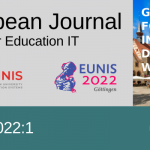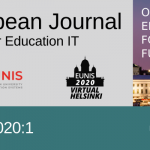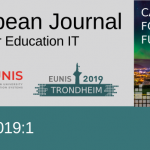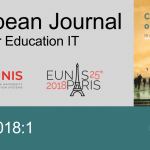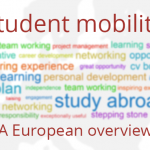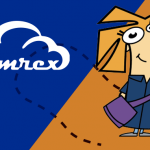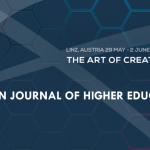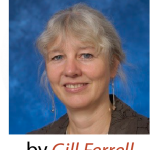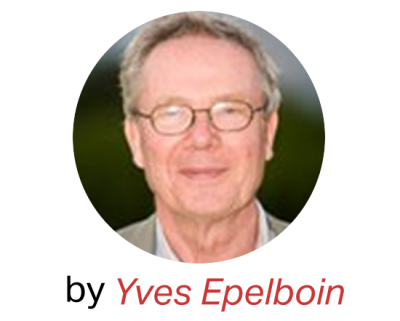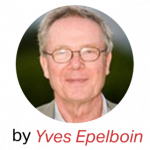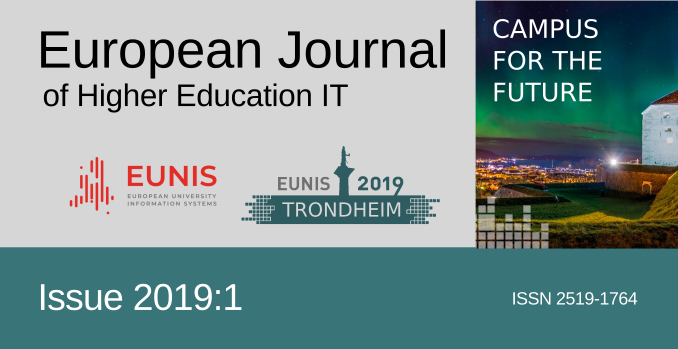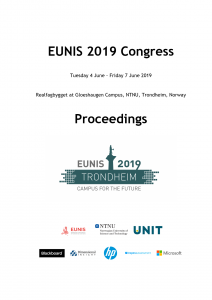
Reference to articles in this issue should be made as follows: name of author(s). title, European Journal of Higher Education IT 2019-1
European Journal of Higher Education IT – EJHEIT
This issue of the European Journal of Higher Education IT (2019/1) consists of a selection of the full papers from the EUNIS 2019 congress.
A total of 33 papers were accepted for the congress, 21 of which are published here.
In this issue there are a variety of themes in the tracks “Leadership & management” to “Learning, teaching & student experience”
European Journal of Higher Education IT is a journal created to support the mission of EUNIS and to disseminate International Research within the field of higher education IT. Please also refer to the Editorial Committee.
ISSN 2519-1764
Leadership & management
IT Strategy in the Era of Digital Transformation: Case Higher Education
Pekka Kähkipuro
Abstract
The role of an IT strategy is changing radically with the progress of digital transformation. This is natural as IT is moving from a supporting role closer to the core of the business. Higher education is no exception: IT is now visible in nearly all activities both within the business and also in the supporting functions.
As a result of the role change, there is a new set of expectations for a successful IT strategy. Moving into the core of business requires a new approach in target setting and in the way IT’s direction is defined. We briefly analyse the shortcomings of traditional IT strategies and how the additional needs have been addressed so far. While these approaches allow organisations to proceed with their digital development work, the outcome has often been a complex patchwork of strategy documents and related activities. To solve the issue, we propose a model where digital capabilities provide the underlying structure for bridging the gap between the new requirements and traditional IT delivery. This allows the inclusion of organisation-wide business aspects into the strategy while keeping the role of IT clearly visible. As a consequence, the use of digital capabilities in the strategy blends the business with technology in a seamless way, just like in real life. To illustrate the approach, we analyse how the proposed approach can be applied to the higher education sector. Examples of higher education are used throughout the paper. This demonstrates that the model works in practice and provides an example of using it in a complex and multi-faceted industry.
Information Management @ Universities: a model proposal
Maria Manuela Pinto
Abstract
This communication aims to present the main result of a research in the field of Information Management (IM), acknowledged as a cross-sectional and applied area in Information Science (IS).
It is based on a diagnosis made at Portuguese Public Universities, complemented by a more detailed study performed at the University of Porto (U.Porto) involving traditional information services (Archives, Libraries, Documentation Centres and Museums), an area that, in the last few decades, has sustained epistemological and theoretical changes which have impacted on training and investigative models, functional contents and professional profiles, as well as emerging services such as Informatics and the role of IM, that tend to dominate IM in the digital milieu.
The info-communicational flow is considered in its several stages and contexts and managed under the concept of information (human and social phenomenon). IM is defined as the study, conception, implementation and development of processes and services related to the info-communicational flow, serving to build implementation models for maximum efficiency and profitability.
The prospective vision is embodied in the proposal of an Active and Permanent Information System Management Model (MGSI-AP) for the university.
The taming of Masaryk University websites
Pavel Budík
Abstract
In this paper we describe the process of modernizing the online presence of Masaryk University, focusing mainly on the technical aspects. Specifically, we discuss how we managed to start a widespread adoption of a single content management system, unify design, and at least partially resolve content problems for about 130 websites. We present a centralized content management system which helps tackle security and technology issues, as well as a design framework which ensures consistency of the websites’ looks.
Cheating Detection: Identifying Fraud in Digital Exams
Bastian Küppers, Julia Opgen-Rhein, Thomas Eifert, Ulrik Schroeder
Abstract
Digital exams are more and more adapted in institutions of higher education, but the problem of preventing cheating in those examinations is not yet solved completely. Electronic exams potentially allow for fraud beyond plagiarism, because the usage of computers during the exam technically enables the students to communicate with each other or to access online resources. Therefore, possibilities to detect impersonation and prohibited communication between the students in-situ and a-posteriori are desirable. To implement these measures, several techniques from the fields of artificial intelligence and statistical analysis can be used. This paper describes the required conditions for both, in-situ and a-posteriori detection, as well as the techniques that can be applied. As a result, we show methods with very high detection probability of cheating and thus a credibility of e-Assessments at least at the level of paper based exams.
Conduction of Exams: Analogous vs. Digital
Bastian Küppers, Thomas Eifert, Ulrik Schroeder
Abstract
Digital examinations and paper-based, analogous examinations differ in substantial aspects, concerning both the formalities and the preparation, conduction and grading of the exam. As with digital exams, often security issues are mentioned as reasons against them. This paper focuses on the conduction of the exam and points out why digital exams cannot only provide a similar notion of security and practicality as analogous exams, but how digital exams can excel the analogous variants of exams. For the course of the paper, exams for programming courses in a computer science study course as well as a math course, as offered in the bachelor study program “Applied Mathematics and Computer Science” at FH Aachen University of Applied Sciences, will serve as an example to illustrate certain points.
ICT infrastructure & security
eIDAS eID & eSignature for HEI/EDU Applications
Hermann Strack, Guido Bacharach, Sebastian Klinner, Oliver Otto, Andre Schmidt
Abstract
University domain/scenario use cases based on eIDAS eID & eSignature extended user service accounts are implemented in the EU CEF projects TREATS and StudIES+, integrating hybrid ID concepts (legacy & eID). eNotar services will offer to integrate legacy binding in process and document flows, transfers to other areas are considered (Industry 4.0, ABAC).
(Recipient of the EUNIS Elite Award)
Implementing an Opensource Higher Education and Research ERP at the scale of a country or State. Case Study: The Malian Higher Education Information System
Jean Marc Coris, Stuart McLellan
Abstract
Cocktail is the name of a French opensource university ERP. It has been designed as a seamless resource management IMS/ERP for French universities and higher educational institutions. The project started in 1993 with the initiative of this article’s author, Jean Marc Coris. At that time, he was CIO at the newly created La Rochelle University, SW France.
Built incrementally upon a single data repository, it grew, over time, with the contributions of a community of developers, into a complete higher education -MIS/ERP, meeting the varying demands of French higher education institutions. As the authors and contributors were either civil servants or employees of public institutions it was a natural choice to license the product as Cecil Open-Source.
On the Decentralization of IT Infrastructures for Research Data Management
Marius Politze, Thomas Eifert
Abstract
National and international initiatives and the spread of data driven algorithms, recently put Research Data Management to more attention. Researchers can already choose from a variety of services; however, tasks like publishing, keeping public records or long-term storage often remain disjointed in researchers’ workflows. While viewed as a university wide and generic task, the benefit of data management for researchers is likely indirect. Hence, the integration into research processes is a central challenge when establishing IT support for a data management system. From the IT service providers perspective this marks only a fine line between centralized generic services and specialized individual ones. Considerations between individualization, efficiency, personalization and sustainability are becoming more important, especially when it comes to publication and long-term storage of research data or for researchers’ processes relying on central components.
We therefore strive to integrate individual research processes with central infrastructures. The realization of such a decentralized data life cycle depends on a shared set of services: digital identifiers like DOI and/or handle, meta data standards and formats, technologies for data preservation and interfaces for research process integration. This set of technologies allowed defining and implementing various processes within the data management system at RWTH Aachen University.
ICT in research
The sciebo.RDS Project: Who says research data management has to be complicated?
Raimund Vogl, Anne Thoring, Dominik Rudolph, Holger Angenent, Jürgen Hölters, Markus Blank-Burian
Abstract
The project “sciebo Research Data Services (sciebo.RDS)” aims to create easy-to-use, integrated research data management (RDM) workflows for scientists. Based on the established cloud storage service “sciebo”, we will develop tools and interfaces that serve this purpose optimally. In concrete terms, tools for creating data management plans, tools for data analyses, and repositories for long-time archiving have to be connected and integrated. The project is oriented towards specific use cases, especially from the humanities, and always closely aligned to the users’ needs.
OMEGA-PSIR: An ecosystem for Building University CRIS Network in Poland
Henryk Rybiński, Jakub Koperwas, Łukasz Skonieczny, Wacław Struk
Abstract
OMEGA-PSIR, developed at the Warsaw University of Technology (WUT), is an institutional Current Research Information System (CRIS). At University it can be used for various purposes, such as presenting the University research, knowledge management, internal research assessment purposes, as well as reporting to the National Authorities in Poland. Since 2015 one can observe a growing interest among the Polish universities. It is now adopted by 15 universities in Poland. In the paper we will discuss how the bottom-up initiative of the Polish universities became a successful approach for building a low-cost network of the institutional CRIS systems, cooperating with the national CRIS system.
Open Research Data: The current and future use of repositories by the Swiss research community
Markus von der Heyde
Abstract
One way to share the results of scholarly production is to upload publications, in conjunction with the research data underlying them, into a data repository. As of 2017, the Swiss National Science Foundation (SNSF) has mandated making data from funded projects accessible. This provided a reason to examine the sharing and reuse behavior of researchers in the Swiss community in 2018. A “landscape survey” across the complete Swiss research community collected information from 2,384 scientists about their data sharing and reuse practices. In addition, a “repository survey” added the perspective of 208 international repositories and their plans for future development. The results were analyzed using statistical methods.
Generally, the motivation and concerns for data sharing and reuse in the Swiss community are not different from other scientific communities. Overall, about a third of the Swiss research community share data in repositories. The drivers of sharing and reuse that are summarized in this paper, in the sense of motivations and intentions to share and reuse, replicate the main findings in previous literature. We also compare and correlate these drivers with actual data reuse and sharing practice.
The Swiss research community uses international repositories extensively: 75% are based in the EU or internationally. Switzerland provides institutional or financial support for only 13% of all repositories mentioned. Future requirements for services from the Swiss community are not yet met by the international repositories’ plans.
This paper focusses on recommendations to local support units and IT service providers at the university level. Suggestions for local measures as well as collaborative approaches are anchored in the results gained from the original data analysis. A change of perspective is the main point: If organizations encourage reuse of data, sharing will consequently rise.
OpenX & interoperability
Erasmus Without Paper Network — from development to production
Janina Mincer-Daszkiewicz
Abstract
EWP (Erasmus Without Paper) is the European project co-financed in years 2015-2017 by the Erasmus+ Programme, Key Action 3 (Prospective Initiatives — Forward Looking Cooperation Projects). EACEA has prolonged funding for years 2018-2019.
In December 2018, three years after the start of the first EWP project, in front of 350 participants from across Europe gathered in the stunning aula of the University of Ghent, and many more following the event via live stream, the Erasmus Without Paper Network was officially launched. Teams representing SOP from Austria, QS Unisolution from Germany, SIGMA from Spain, MUCI from Poland, University of Ghent from Belgium, and University of Porto from Portugal conducted live demo showing exchange of mobility data between their Student Information Systems.
The event does not mark the end of the EWP project, but is the milestone turning the development stage into production. The most challenging activities are still ahead — industrializing the Network and its elements, integrating data transfer with business processes of student mobility carried at higher education institutions, increasing network coverage by accepting new institutions, supporting new partners in joining the network, on a political, organizational and technical level. This support will be offered by the Competence Center to be established in 2019.
While the network grows, new mobility scenarios are recognized and new APIs to support them are designed and developed. New use cases show up and get support, like reporting from HEIs to the Mobility Tool+, or integrating services offered by other networks (like ESMO or EMREX) into one digital platform for education sector.
The aim of this paper is to show the Erasmus Without Paper Network running in production and supporting student mobility in partner institutions. The components of the Network will be presented and their role explained. Planned tasks and activities of the Competence Center will be discussed. Directions of extension of the Network functionality beyond basic scenarios of the Erasmus mobility will be shown. Plans for the European-wide roll out of the EWP Network will be shared.
The ultimate goal is to show the benefits of the EWP solution and encourage higher education institutions to become part of it.
Software development
Decentralized verification infrastructure for documents anchored to blockchain
Mirko Stanić, Matija Pužar
Abstract
Digitizing student credentials presents several unique problems. Traditionally, the issuers must provide infrastructure for hosting digital documents or choose to outsource it to a third party. In this solution, dangers of potential data breach can never be fully mitigated and the validity of these documents is automatically tied to the existence of the institution that issued them. With the advent of blockchain technology it has become possible to store proofs of existence on a permissionless distributed ledger, i.e. blockchain, thus eliminating the need for hosting complex infrastructure as well as rendering data breaches impossible and enabling ownership of the documents to be efficiently managed in the digital space.
Distributed services and a warehouse as an ecosystem on science and higher education
Emil Podwysocki, Łukasz Błaszczyk, Marta Niemczyk, Jarosław Protasiewicz, Marek Michajłowicz, Sylwia Rosiak, Iwona Kucharska
Abstract
In this study, we demonstrate the concept of a new information ecosystem on science and higher education in Poland. We focus on a distributed architecture of services and a data integrating warehouse. The data warehouse is tailored to be well-suited to micro-services, the modern information system architecture. In addition, we show examples of descriptive and predictive analytics in the data warehouse, which assist policymakers in making decisions. The primary outcome of the study is a new architecture, which relies on combining the data warehouse and micro-services into one ecosystem of distributed services for science and higher education. We hope that our experiences and concepts will be beneficial to those who face challenges in redesigning of existing information systems.
Virtual Campus Supported by Novel Efficient Knowledge Sharing
Arnt Richard Rørvik, Per Atle Eliassen, Jan Erik Garshol, Trude Eikebrokk, Gry Ane Vikanes Lavik
Abstract
Virtual campuses need efficient, user-friendly and seamless creation, search and consumption of open access and internal (restricted access) knowledge resources.
Today’s workflows typically create knowledge resources such as learning objects using standalone tools, subsequently publishing them separately to internal and external knowledge stores. Loss of productivity is an obvious disadvantage, due to manual re-entries, file copying and versioning woes across sources and destinations. Resources published in one or more Internet accessible systems are often lacking study information system (SIS) furnished metadata. Add to this differing metadata schemes and manual entries of storage systems and publishing targets. The resulting cumbersome and non-intuitive workflow and lack of relation between related resources published more than one place, hampers the production and sharing of resources.
NTNU and BIBSYS (now Unit) cooperated in bridging this gap in the Digtal Learning Resources (DLR) effort, taking care of both internal (eLS/LMS/eAS etc.) and open access publishing, while offering high productivity features. DLR has evolved from a simple open source tool with learning technology interoperability (LTI) support of eLSs, into a high-productivity tool facilitating both open and restricted access resources, with a uniform high productivity user interface experience with support for eLS-specific features. Multi-author versioning (in a forking fashion) can be supported, in addition to active resources (code checking, digital twins, simulators etc.) and single click automatic open publishing with a palette of preconfigured licenses (Cc etc.), DOI’s generated automatically and with optional moderation of open access publishing, to one or more open access systems. NTNU and BIBSYS have sponsored the initial development, with the Norwegian Business School (BI), and Oslo Metropolitan University (OsloMet) as well as the University of Bergen joining in to develop this as a vital learning object platform (LOR). The presentations of DLR will discuss some central use cases and features.
RAD-on: An integrated System of Services for Science – Online Elections for the Council of Scientific Excellence in Poland
Jarosław Protasiewicz, Sylwia Rosiak, Iwona Kucharska, Emil Podwysocki, Marta Niemczyk, Łukasz Błaszczyk, Marek Michajłowicz
Abstract
In this study, we demonstrate an information service which supports online elections for the Council of Scientific Excellence in Poland. It is part of an Integrated System of Services for Science, RAD-on (Reports, Analysis, and Data). More specifically, we show the overall architecture of RAD-on, and the most compelling features of the service for use in online elections. The proposed e-voting system implements three phases, namely: (i) candidate nomination; (ii) electorate approval; and (iii) voting, which includes ballot distribution, voting, and result verification. This approach distinguishes itself from a typical e-voting system by paying more attention more carefully to automatic candidate nomination and voter acquisition. Moreover, we have designed processes in the system that strike a balance between security requirements and accessibility to voters. Finally, we present selected statistics from a real online election for the Council of Scientific Excellence in Poland, which took place recently. We hope that our approach, experiences, and the operational challenges which we encountered during this election, may help develop other e-voting solutions.
NeIC’s CodeRefinery Project
Bjørn Lindi, Radovan Bast, Thor Wikfeldt
Abstract
CodeRefinery is a project established by the Nordic e-Infrastructure Collaboration (NeIC) with the ambition of teaching researchers Git(a version control system), collaborative tools like GitHub, and good practices for dealing with source code and data. Large focus is placed on reproducibility, maintainability and sustainability in developing scientific software. The project has given more than 20 workshops across the Nordic region over a two-and-a-half-year period with more than a total of 500 participants. The project members have found that there is a strong need for software engineering skills across a wide range of scientific disciplines. This paper discusses experiences of the CodeRefinery project.
Learning, teaching & student experience
Finding a place to learn: A mobile study room guide with integrated room occupancy rate indicator
Ramona Renner, Steffen Schaffert, Bernd Decker
Abstract
An essential part of student life is to study – together and alone. Many students look for a place to study on the university campus to be able to better focus or get assistance from fellow students. However, they have problems finding a suitable spot. Freshmen usually do not yet know common places to study and especially while exam preparation phases, the demand for study rooms is high. At these times, students often do not find a place to study or have to invest a lot of time to find it.
At the request of our students and in cooperation with the students’ union executive committee (AStA), we have developed a solution within our university app RWTHApp, which tackles the issues above – a user-friendly study room guide with integrated room occupancy rate indicator. It provides an overview of all official study rooms on campus and their features. Furthermore, it displays an indicator for current and predicted future occupancy rates. Students can find study rooms more easily, plan meeting with fellow students beforehand and thereby collaborate better. They can better cope with times of high demand, because they know more places, in particular previously less known ones. This leads to a better overall occupancy rate of available rooms while resulting in more available seats in each individual room.
Recent surveys about our university app showed that the feature was used to find a study room by 50% of all students using the app. Additionally, the data collected in the process helps our student representatives to reason about the need for additional or differently located study rooms.
The focus of this paper lies in the description of the mentioned feature and its implementation.
(Recipient of the EUNIS Dørup E-learning Award)
A case study in learning spaces for physical-virtual two-campus interaction
Robin Støckert, Alexander Refsum Jensenius, Anna Xambó Sedó, Øyvind Brandtsegg
Abstract
In this paper we present results from our ongoing project Student Active Learning in a Two campus Organization (SALTO). This is funded as part of the Norwegian University of Science and Technology’s (NTNU) Teaching Excellence scheme. The initiative consists of a portfolio of development measures, with the purpose of developing innovative approaches to learning, teaching and assessment. The aim of SALTO is to develop pedagogical strategies for the two-campus master’s program Music, Communication and Technology (MCT). This is a joint program between NTNU and the University of Oslo, with the students being split between the cities of Trondheim and Oslo 500 km apart. The program is built around a shared physical-virtual space – the Portal – with a range of high-quality audiovisual technologies. The SALTO project focuses on how the Portal can be used for all activities in the program, with an emphasis on human-computer interaction, resource sharing and collaboration. This is done by students and teachers exploring educational, methodological, and technological solutions together. As such, the SALTO project uses the Portal as a ”living lab”, which is constantly evolving and being optimized for student-active learning scenarios. In this paper, we present and discuss three cases from the first year of the project: (1) The MCT Opening Ceremony, (2) A “Christmas concert” between to upper secondary schools in Trondheim and Oslo, (3) An intensive workshop-based course with a mix of preparations, lectures and hands-on exercises. The three cases do in various ways present some of the challenges and possibilities of two-campus teaching.
Digital Native Students’ learning expectations in Higher Education
Anne-Dominique Salamin, Nicole Glassey Balet
Abstract
This paper presents the results of a wide survey conducted in 2013, repeated in 2016, among 17,000 then 19,000 students at the University of Applied Sciences Western Switzerland (HES-SO), to better apprehend how students consider their training, their relationship to technologies and their expectations as “digital natives” students with regard to teaching. This bottom-up approach included digital native students’ expectations, needs and requests concerning tools and new teaching approaches. The outcome of the two surveys depicts the new student who enrolls into higher education institutions. This paper presents the combined results of these two surveys and the measures ensued, namely the development of training modules on digital change and the design of an adaptative Moodle quiz.
Digital university: student perspective
Anna Pacholak
Abstract
The paper presents a summary of the findings from the student digital experience insights survey carried out among students of the University of Warsaw in the summer semester 2018. It provides an overview on how students use technology at the university, for their own learning purposes and how they perceive the university digital provision as well as the digital teaching and learning on their courses.
The dataset is valuable in its potential to explore the digital experiences of students and in highlighting what exactly makes a difference to them. The findings of the survey are of use in identifying which areas of the digital education at the university should be developed as priority ones and deliver data upon which strategic decisions about digital improvements (including academic staff trainings and e-services) can be made. The findings obtained enable benchmarking for other HE institutions.

